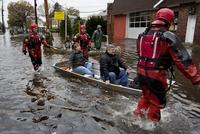-
Disaster communicationSafeguarding networks when disasters strike

Disasters both natural and human-caused can damage or destroy data and communications networks. Several presentations at the 2014 OFC Conference and Exposition, being held 9-13 March in San Francisco, will present new information on strategies that can mitigate the impacts of these disasters. Researchers created an algorithm that keeps data safe by moving or copying the data from data centers in peril to more secure locations away from the disaster. The algorithm assesses the risks for damage and users’ demands on the network to determine, in real-time, which locations would provide the safest refuge from a disaster. Other researchers suggest that if fiber-optic cables are down, wireless communication can fill the void and be part of a temporary, emergency network. For such a system to work, however, wireless technology would have to be integrated with the fiber-optic network that transports data around the world.
-
-
CybersecurityMaking cybersecurity a political issue
U.S. federal agencies have reported a dramatic rise in the number of cyberattacks over the past few years, with reported cyber incidents rising from 5,503 in 2006 to 48,562 in 2012. Since cyber incidents pose such a threat to national security and infrastructure, could cybersecurity become a political campaign issue? Experts say that if politicians were to focus their attention, and their constituents’ attention, on cybersecurity, the United States could be made safer from cyberattacks before a “cyber Pearl Harbor” – or a “cyber 9/11” – occurs.
-
-
ResilienceResources on disaster preparedness, resilience

One year after Superstorm Sandy hit the eastern United States, local, state, and federal agencies as well as community groups and businesses are working to strengthen the U.S.s resilience to future disasters. A National Research Council (NRC) has issues a series of studies and reports, and has put together workshops and study groups, which should advance the national conversation on preparedness and resilience.
-
-
Emergency servicesFlorida blood service upgrades storage systems
Florida Blood Services has replaced three disparate storage systems with the Nimble CS240 converged storage array; FBS says the new storage operation allows FBS more efficient and centralized storage for FBS’s headquarters and forty field offices
-
-
CybersecurityDoppelganger Domains threaten 30 percent of Fortune 500 companies
30 percent of Fortune 500 companies are vulnerable to Doppelganger Domains attacks; a Doppelganger Domain is a domain spelled identically to a legitimate fully qualified domain name (FQDN) but missing the dot between host/subdomain and domain, to be used for malicious purposes
-
-
CyberwarIran's control systems attacked by another virus

Iran admitted it has been attacked by another virus aiming to disrupt its industrial control systems; the commander of Iran civil defense said, though, that the virus has been caught in time and neutralized by Iran’s “young experts”; Gholamreza Jalali described the virus as “congruous and harmonious with the (computer) system and in the initial phase it does minor damage and might be mistaken for some executive files of government organizations”; in the summer, nearly 42,000 computers and servers in Iran’s industrial control systems — many of them in Iran’s nuclear weapons program — were infected; the damage to uranium enrichment centrifuges was especially great, causing Iran in mid-November to halt enrichment operations; Stuxnet has also infected the Bushehr nuclear reactor; the reactor was supposed to come on line in August, but it is still not operational, and has missed several start-up deadlines
-
-
DisastersHurricane-proof data center built inside 770,000 gallon water tank
The city of Altamonte Springs, Florida decided that the best protection against downtimes caused by hurricanes is to build the city’s data center inside a 770,000 gallon water tank; the dome-shaped tank offered 8-inch-thick walls of reinforced concrete and was situated only 100 feet from City Hall
-
-
Vulnerable IT infrastructure means loss of revenue
Europeans businesses are losing approximately 17 billion Euros a year in revenue owing to IT disruptions; on average, European businesses suffer IT failures lasting an average of fourteen hours per company a year, amounting to nearly one million hours of down-time costs
-
-
New forensic tool advances data recovery
Data recovery for images will be applied to other file types; new text tool will make it possible to recover more data from corrupted hard drives; the text tool will examine fragmented chunks of files that may be distributed across a disk and analyze their content to see which ones likely go together
-
-
Onyx targets business continuity acquisitions
Energetic and acquisitive U.K. VAR Onyx refreshes DRS proposition after recent buy-out and aims for more consolidation; company claims that many disaster recovery packages do not cater effectively for smaller firms, particularly in London
-
-
How to make an organization more resilient
Small and mid-sized organizations are especially at risk when disaster strikes, since few have the resources or knowledge to develop full-scale continuity plans; CDW-Government offers seven useful tips on how to make organizations more resilient; CDW-G’s experts argue that the most important thing for an organization during a disaster is to ensure the integrity of its data, communications capabilities, and the information technology infrastructure to support both
-
-
Company in the newsAxxana, a data storage and recovery specialist raises $9 million
Axxana, an Israeli developer of data disaster recovery solutions, has raised $9 million in Series B funding; Carmel Ventures led the round, and was joined by return backers Gemini Israel Funds and serial investor Moshe Yanai
-
- All
- Regional
- Water
- Biometrics
- Borders/Immig
- Business
- Cybersecurity
- Detection
- Disasters
- Government
- Infrastructure
- International
- Public health
- Public Safety
- Communication interoperabillity
- Emergency services
- Emergency medical services
- Fire
- First response
- IEDs
- Law Enforcement
- Law Enforcement Technology
- Military technology
- Nonlethal weapons
- Nuclear weapons
- Personal protection equipment
- Police
- Notification /alert systems
- Situational awareness
- Weapons systems
- Sci-Tech
- Sector Reports
- Surveillance
- Transportation
Advertising & Marketing: advertise@newswirepubs.com
Editorial: editor@newswirepubs.com
General: info@newswirepubs.com
2010-2011 © News Wire Publications, LLC News Wire Publications, LLC
220 Old Country Road | Suite 200 | Mineola | New York | 11501
Permissions and Policies
Editorial: editor@newswirepubs.com
General: info@newswirepubs.com
2010-2011 © News Wire Publications, LLC News Wire Publications, LLC
220 Old Country Road | Suite 200 | Mineola | New York | 11501
Permissions and Policies
